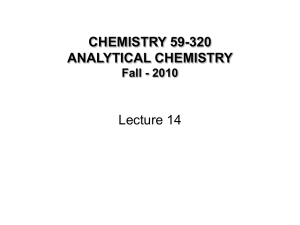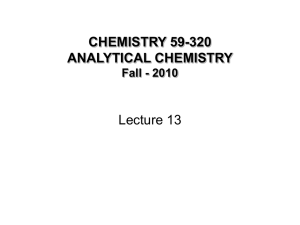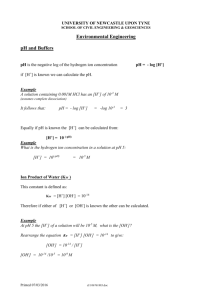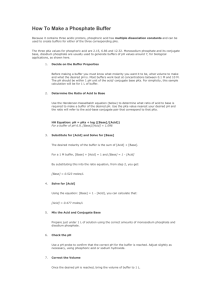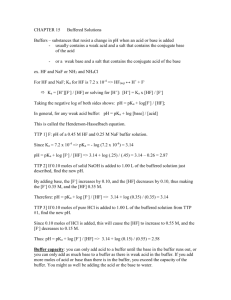Chapter 9 Buffers
advertisement
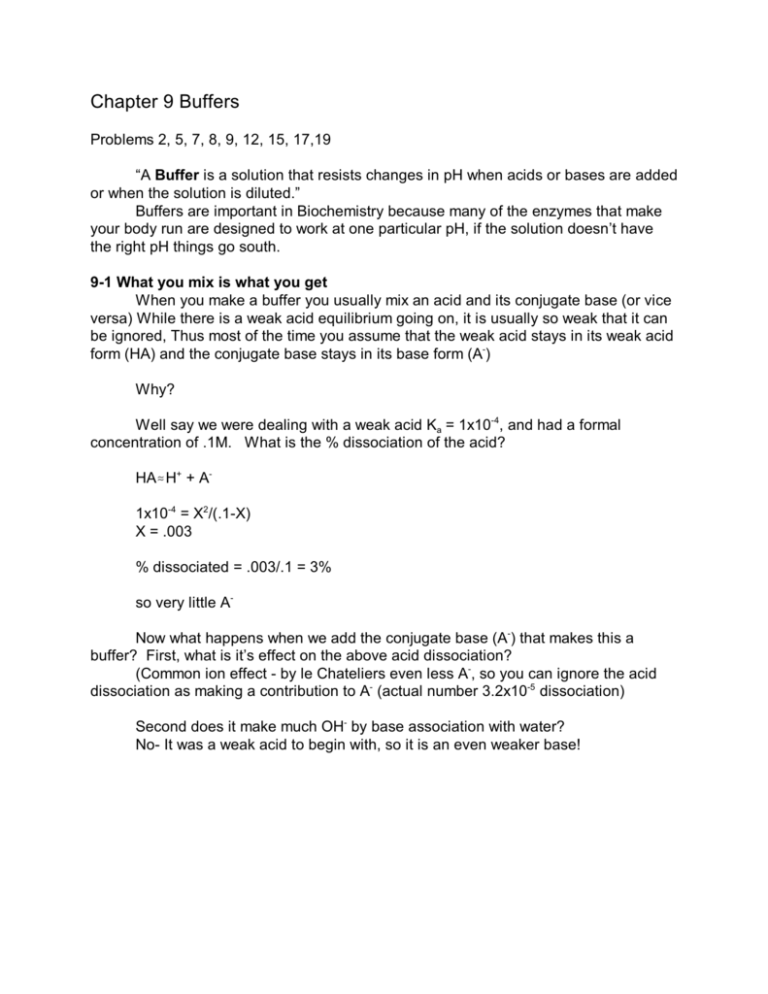
Chapter 9 Buffers Problems 2, 5, 7, 8, 9, 12, 15, 17,19 “A Buffer is a solution that resists changes in pH when acids or bases are added or when the solution is diluted.” Buffers are important in Biochemistry because many of the enzymes that make your body run are designed to work at one particular pH, if the solution doesn’t have the right pH things go south. 9-1 What you mix is what you get When you make a buffer you usually mix an acid and its conjugate base (or vice versa) While there is a weak acid equilibrium going on, it is usually so weak that it can be ignored, Thus most of the time you assume that the weak acid stays in its weak acid form (HA) and the conjugate base stays in its base form (A-) Why? Well say we were dealing with a weak acid Ka = 1x10-4, and had a formal concentration of .1M. What is the % dissociation of the acid? HA.H+ + A1x10-4 = X2/(.1-X) X = .003 % dissociated = .003/.1 = 3% so very little ANow what happens when we add the conjugate base (A-) that makes this a buffer? First, what is it’s effect on the above acid dissociation? (Common ion effect - by le Chateliers even less A-, so you can ignore the acid dissociation as making a contribution to A- (actual number 3.2x10-5 dissociation) Second does it make much OH- by base association with water? No- It was a weak acid to begin with, so it is an even weaker base! 2 9-2 The Henderson-Hasselbalch Equation Since we can ignore the dissociation of the acid, we can rearrange the Ka equation into a more convenient form Ka = [H+][A-]/[HA] log Ka = log[H+] + log( [A-]/[HA]) pKa = pH -log( [A-]/[HA]) pH = pKa + log( [A-]/[HA]) (for an acid) The equivalent H-H equation for a base is: pH = pKa log ([B]/[BH+]) Where pKa refers to dissociation of the BH+ conjugate acid NOT the pKB of the base When A- = HA, pH = pKa If you study the H-H equations you will see that when [HA]=[A-] you have log 1/1 =log 1 =0 and pH=pKa. So when this occurs you have an easy pH to calculate. When [A-]/[HA] changes by a factor fo 10, pH changes by 1 unit Same idea say [HA] = 10X [A-] log [A-]/[HA] = x/10x log [A-]/[HA] = 1/10 = -1 -andLog (10/1) = 1 Also note: when [A-] > [HA] pH > pKa When [A-]<[HA] pH< pKa A H-H type problem Simple forward: I am going to mix 50 mls of .5M Sodium acetate with 25 ml of .1M acetic Acid, 3 what is the pH of the resulting buffer solution? First, what are the concentrations of A- and HA in the mixed solution? I am mixing 50 mls of one solution with 25 of another, so my total volume is 75 ml Using M1V1 = M2V2 Sodium acetate will ionize completely so I have .5M Na+ and .5M Acetateand acetate- = ATaking into account the complete dilution then [A-]: .5(50) = X (75) X = .5(50)/75) = .333M Acetic Acid is HA [HA] : .1(25) = X(75) X = .1(25/75) = .033333 pH = pKa + log [A-]/[HA]; pKa acetic acid = 4.757 pH = 4.757 + log (.333/.0333) pH = 5.757 (note pH > pKa and this checks with [A-]>[HA] Now let’s try a harder problem going in the other direction, start with a pH and come up with [HA] and [A-] Let’s say the total (formal concentration of [HA] and [A-] should be 1M, and I want the pH to be 5, and again I will use acetic acid with a pKa of 4.757 ie [HA] + [A-] = 1M pH=5 pKa = 4.757 4 Using the H-H we have 5 = 4.757 + log[A-]/[HA] Let’s say X= [A-], then [HA]=1-X and 5 = 4.757 + log (X/(1-X)) 5 - 4.757=log(X/(1-X)) 0.243=log (X/(1-x)) 100.243= X/1-X 1.75=X/1-X 1.75-1.75X=X 1.75=2.75X X=1.75/2.75=.636 = [A-] so [HA] = 1-.636 = .364 9.3 A buffer in action The whole idea of a buffer is that it is a solution that resists changes in pH. Let’s test this out Say I have 1 l of pure water, what is its pH ? (7) Now lets start with 1 l of pure water and add 5 ml of 10M HCl, what happens to the pH? Total volume is now 1.005 L [H+] using dilution equation: M1V1 = M2V2; .005(10) = 1.005(X); X = .005(10)/1.005 = .04975 pH = 1.3 So pH dropped from 7 to 1.3, a swing of 5.7 pH units What would have happened if we were using the buffer we just calculated? Initial pH = 5 How do we figure out what the acid does??? Chemically the acid will react with what? The weak acid or its base? (Its base) So we had just determined that [HA] = .364, and [A-] = .636 5 and if we have 1 l then Moles [HA] = .364, and mole A- = .636 But now the acid is going to react with the base A- + H+ 6 HA Moles H+ = .005(10) = .05 moles So the reaction table Buffer Acid RXM A.636 H+ . .636-.05 05 0 HA .364 .364+.05 so [A-] = (.636-.05)1.005 = .583 [HA] = (.364+.05)/1.005 = .412 pH = 4.757 + log .583/.412 = 4.757 +.151 = 4.908 so my pH has dropped from 5 to 4.908, all of ~.1 pH units. Yes this resisted a change in pH!! There are two things I want you to notice 1.) one was in the last calculation. Notice how I went from moles to molarity and then took [A-]/[HA] . Did I have to convert from moles to molarity? NO to covert to molarity divide by volume, but in next step volume/volume cancels out. So this is extra useless math! 2.) How do buffers work? The acid reacts with base, and the base with acid, as long as I have both acid and base left in the solution it will continue to buffer. What if I had tried 5 ml of 10M NaOH? ( that would just about have blown the buffer away) 9-4 Preparing Buffers While calculation like the above are common on quant tests, what happened if you make this solution up? You actually never get the pH right. This is because real ions usually act a little differently than their concentrations. There is a correction for this called an activity coefficient that we will get to in chapter 11. For now just take my word for it. Besides that, you usually make small errors when you weigh thing and the Ka’s are temperature dependent as well, and all these combine to throw your final pH off. When you are in the lab what you usually do is to mix the chemical you want to form a buffer together, make up the solution to about 80% of its final volume, check the 6 pH with a pH meter, then add a little acid or base to adjust to exactly what you want, then add the remaining liquid to make the total volume. If you want to be very exact, you always need to actually check the pH of the buffer before you use it. Some buffers are sensitive to changes in ionic strength, so their pH will change as they are diluted, others are sensitive to temperature, so their pH will shift as the temperature of the experiment changes. Bottom line, double check any critical experiment! 9-5 Buffer Capacity We won’t spend too much time on buffer capacity, but I do want you to remember that when choosing an acid or base for an experiment you need to chose one whose pKa is as close as possible the pH you are trying to buffer for. Also the buffer works best in the region where you are ± 1 pH unit from the acids pKa. IF you think back to the acetic acid buffer example we have been using you will see that this is actually a good example. The pKa. of Acetic acid is 4.757, so it work best as a buffer between 3.757 and 5.757. In our example problem we have been buffering at a pH of 5, and this is inside the optimum range for this acid. Your task is to look at the Books table of commonly used buffer (Table 9-2 184) and come up with a better buffer (There really doesn’t seem to be one!) 9-6 How Indicators Work What is and indicator? -Its just another acid or base, the only difference is that its acid form has a different color than the conjugate base form. Let’s choose one, Bromocresol green that we will be using in a couple of our labs. It has a pKa of 3.8-5.4. Its structure is shown below: It is yellow in the HA form and blue in the A- form. If this is an acid, where is its buffer region? Around pH 4.7 Where so we have the best buffer? 7 From -1 to +1 pH unit around the pK or 3.7-5.7. Do you know why? (Yesterday’s lecture) At 3.7 A-/HA=1:10 and 5.7 =10:1 Lets use this to think about the concentrations of HA and ApH 1 3 4 5 6 7 8 9 HA 1 1 .9 .5 .1 0 0 0 A0 0 .1 .5 .9 1 1 1 Color Y Y Y/G G G/B B B B So you see two distinct colors <pH4 yellow > pH 6 Blue and one region of muddled color 4-5 varying yellow/green 5-6 varying green/Blue Now what if we are doing a titration that has and endpoint at pH 5? Well, if the titration is set up right, the pH should swing from 4 to 6 within a drop of titrant at the equivalence point. Thus before the equivalence point you will be yellow. And then, within one drop of the equivalence point the pH swings to 6, and the color changes directly to Blue, and you never have a chance to see the intermediate green color! This is ideal if you can’t see intermediate color, you can’t get confused where the endpoint is Thus The pKa of your indicator should match the pH at the equivalence point as closely as possible, at least to within 1 pH unit. Now think a little more... if your indicator is an acid or a base, do you want to have tons of it in solution with your unknown? No you use up some amount of your base titrating you indicator, any you endpoint will be off by that much. Always try to use the minimum amount of indicator! Actually not that bad, colors are usually very intense. Did you all read Box 9-2 the Secret of Carbonless Copy Paper? Acid/base indicator is inside polymeric microcapsules in top sheet of paper the pressure of your pen break the microcapsules and releases the indicator the indicator released onto the lower sheet of paper the lower sheet contains Bentonite (mined just west of Belle) Bentonite is an acidic clay. This acid makes the indicator change color and that is the color you see on the lower page.


